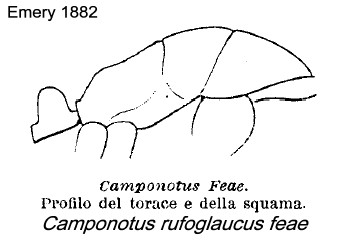Camponotus (Myrmosericus) feae Emery)
  Type locality Spain,
Canary Islands (replacement name for pubescens,
Brullé, 1840: 84, worker; Emery, 1882: 449, illustrated, minor &
major workers) Canary Is is separated as a distinct species;
see
the bottom of this page. Type locality Spain,
Canary Islands (replacement name for pubescens,
Brullé, 1840: 84, worker; Emery, 1882: 449, illustrated, minor &
major workers) Canary Is is separated as a distinct species;
see
the bottom of this page.
|
 Emery (1882) described Camponotus Feae n. sp.,
from Alegranza I., Canary Islands, one major (illustrated right) and
several minors, as follows - (from the Latin) Emery (1882) described Camponotus Feae n. sp.,
from Alegranza I., Canary Islands, one major (illustrated right) and
several minors, as follows - (from the Latin)
WORKER - TL 4.5-7 mm. Colour black; mandibles and
appendages piceous rust. Subopaque; head subtly reticulate; thorax
transversely rugose; gaster with fine tranverse striations, sparsely
puncturate. Pubescence white and adpressed rising from puncturations;
hairs white but few. Mandibles with six teeth, grossly puncturate.
Clypeus carinate, anterior lobe produced, finely reticulate, opaque.
Alitrunk dorsum convex; anterior metanotum flat to subconcave,
propodeum humped. Petiole scale simple but enlarged, posteriorly
depressed (impressed?), upper margin arcuate, somewhat truncate in the
major. Gaster segments with a light posterior margin and pale hairs.
Tibiae and scapes lacking hairs. This is at  . .
Emery's (1893c) description of Canary Island forms is at
 . In this he reduced "feai""
to a variety of rufoglaucus. . In this he reduced "feai""
to a variety of rufoglaucus.
This remains unresolved, or may be not, as Barquin
(1981) synonymized the Canary Islands varieties under C.
rufoglaucus feai but Espadaler (2007) lists "Camponotus feai
Emery" from El Hierro, Canary Islands, noting: "all populations from El
Hierro belong to the homogeneous black phenotype; some populations from
other islands show a remarkable variation in colour of head and thorax,
from pure black to a splendid red".
Barquin, J. 1981. Las hormigas de Canarias. Taxonomia, ecologia y
distribucion de los Formicidae. Secret. Publ. Univ. La Laguna Col.
Monograf., 3, 1-584
Given that this is small, TL 4.5-7 mm; has a base colour
of black, a distinct propodeal profile and a thick petiole scale, it
seems justifiable to follow Espadaler and regard C. feae as a
separate species.
|